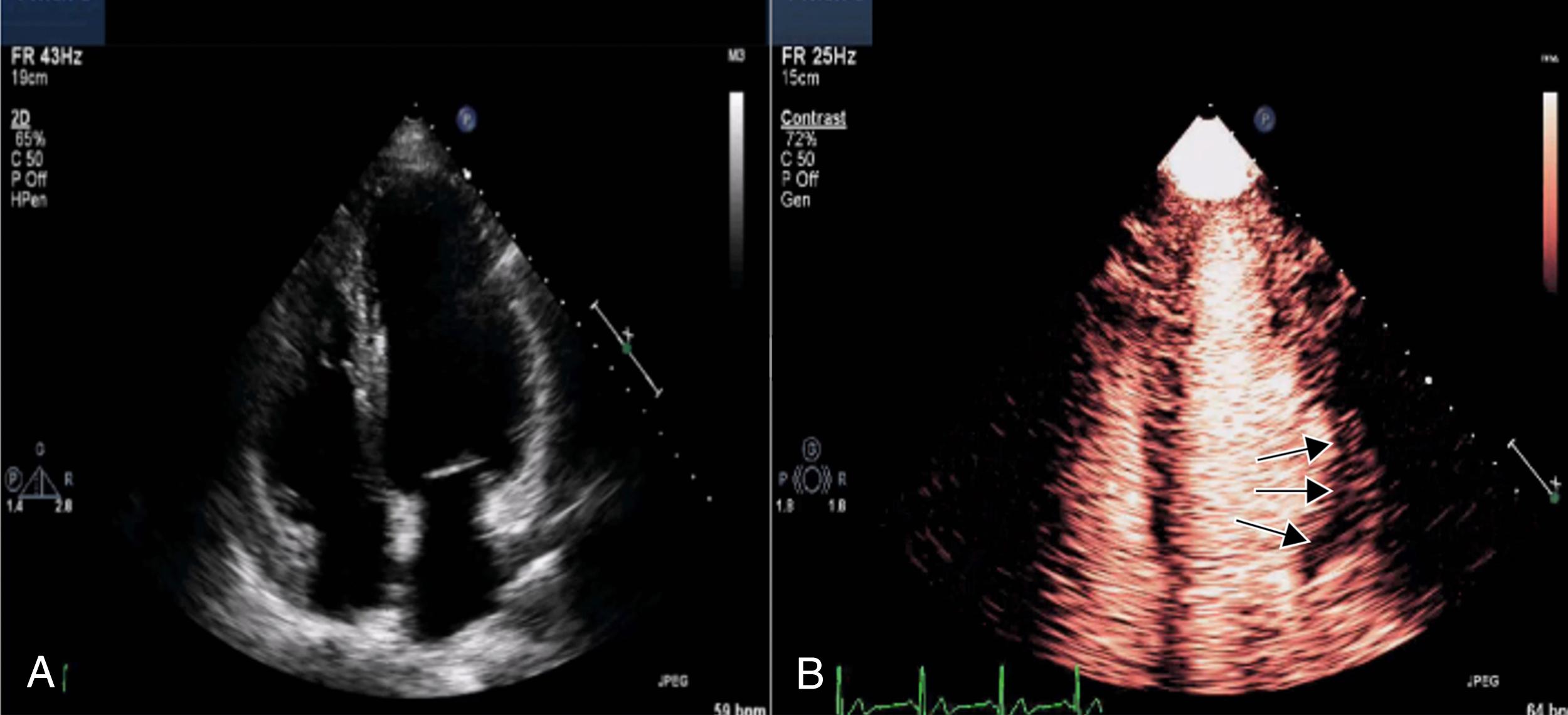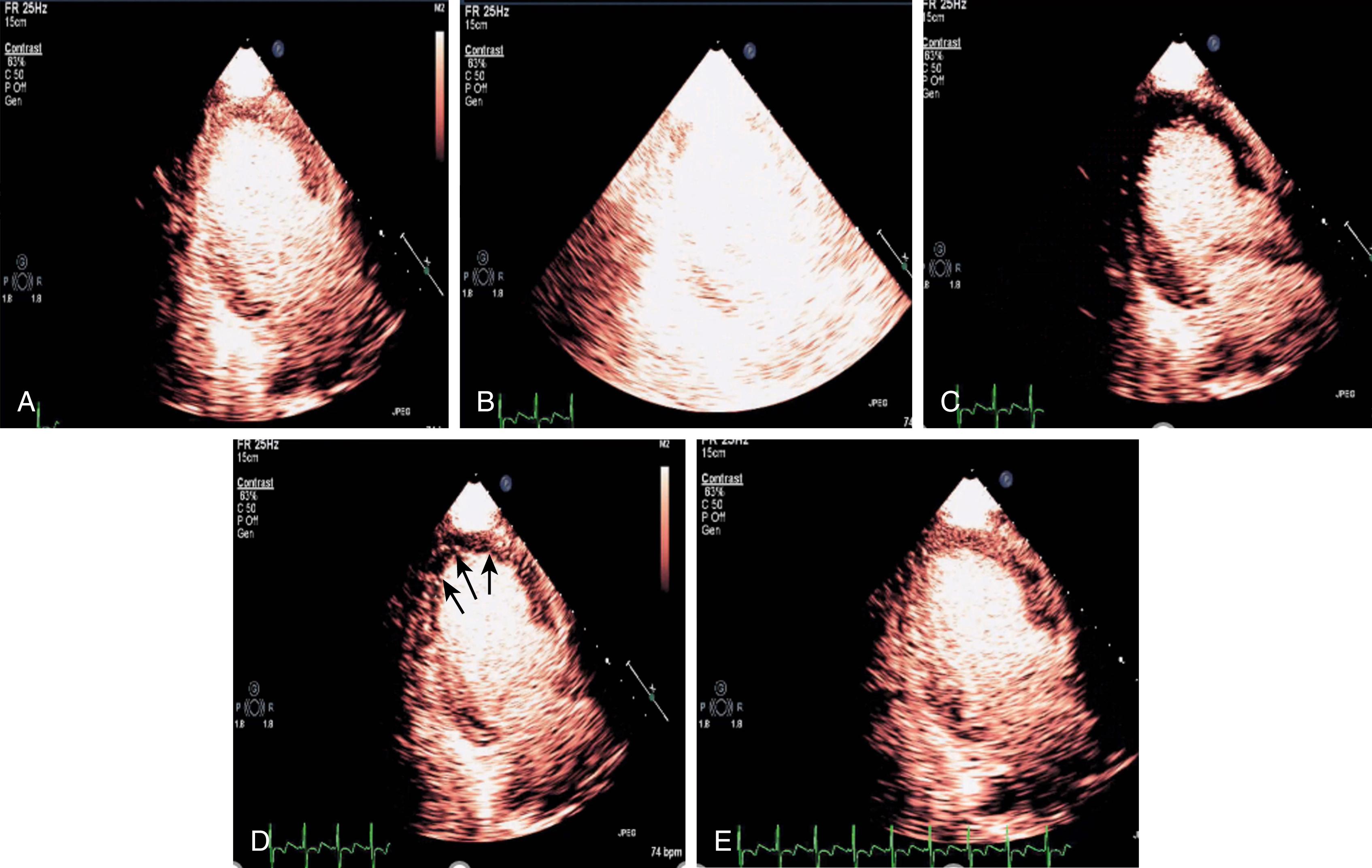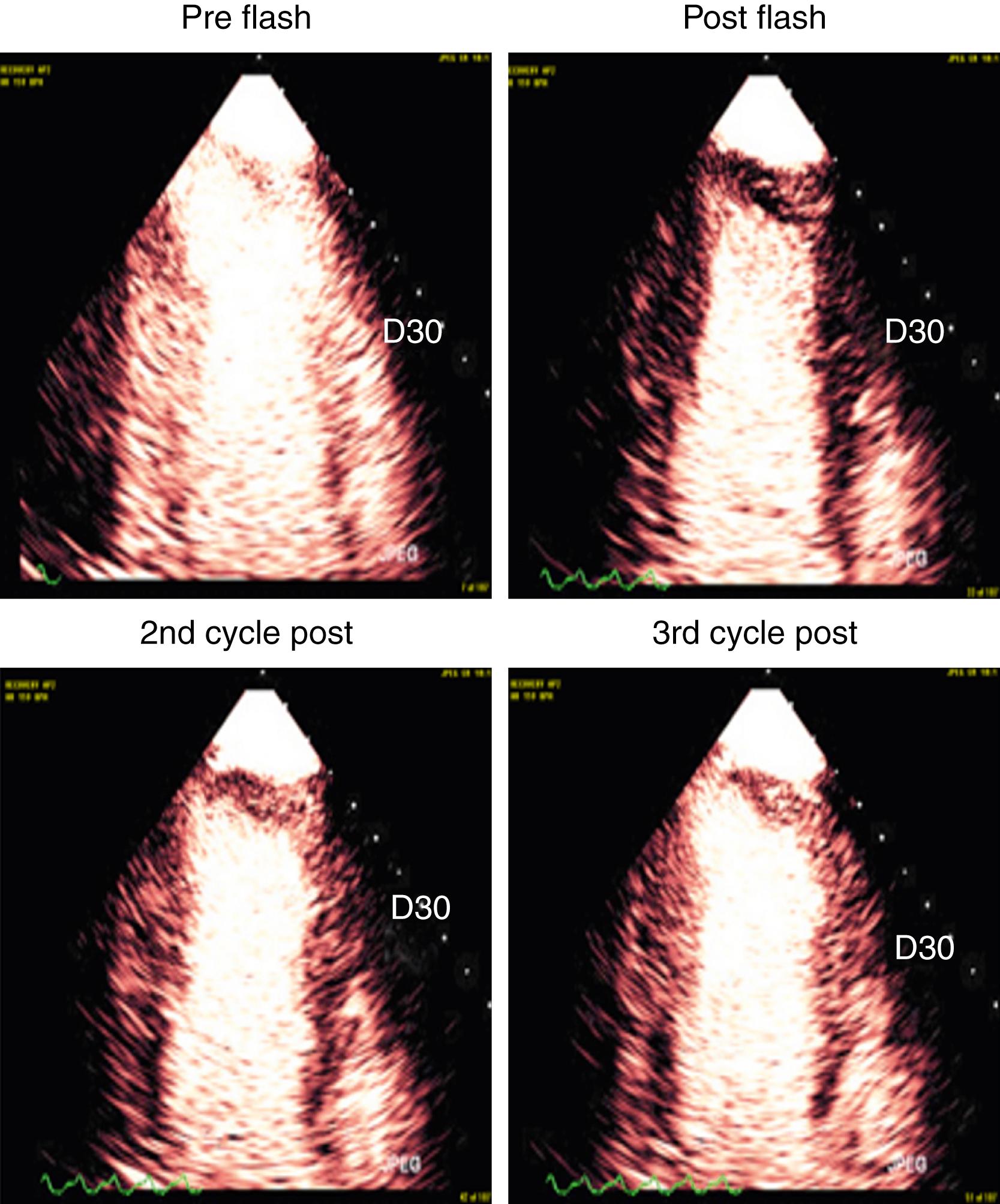Physical Address
304 North Cardinal St.
Dorchester Center, MA 02124
In the updated 2018 guidelines for ultrasound-enhancing agents (UEAs), it was recommended that UEAs be used whenever a coronary artery territory cannot be completely visualized on unenhanced echocardiography. This becomes especially relevant during stress echocardiography (SE), when all segments must be visualized to adequately assess regional wall motion (WM) at rest and during any form of stress. Very low mechanical index (VLMI) imaging techniques (fundamental nonlinear imaging) have resulted in excellent visualization of basal, mid, and apical segments and are currently recommended for almost all UEA applications. , Use of UEAs when resting images are suboptimal has resulted in sensitivities and specificities for the detection of coronary artery disease that are equivalent to echocardiograms performed in patients with optimal image quality.
However, UEAs can also be used to examine myocardial perfusion with the same VLMI imaging techniques (available now on Philips, Siemens, Esoate, and General Electric ultrasound scanners). Perfusion imaging adds incremental value to resting WM assessment during pharmacologic SE with exercise, dobutamine, or vasodilator SE. Perfusion imaging adds incremental predictive value to stress WM assessment. Perfusion imaging during dobutamine or exercise SE also detects abnormalities that antedate wall motion abnormalities (WMAs) and helps delineate subendocardial wall thickening abnormalities that are induced even when overall transmural wall thickening appears normal ( Table 55.1 ). Compared with other perfusion imaging techniques, VLMI has high spatial and temporal resolution such that WM and perfusion can be analyzed simultaneously. It also has lower cost than other perfusion imaging techniques ( Table 55.2 ).
| VLMI Imaging | LVO (Harmonic) | |
|---|---|---|
| Frame rate (Hz) | 20–25 | >30 |
| Mechanical index | <0.2 (very low) | <0.3 (low) but >0.2 MI or minimal contrast enhancement |
| Systems when available | Philips, Siemens, GE Healthcare, Esaote | All systems |
| Assess myocardial perfusion | Yes | No |
| Transmural wall motion enhancement | Yes | Yes |
| Subendocardial wall thickening | Yes | Not feasible |
| Use during treadmill or bicycle stress | Excellent (90%) Both WM and MP |
Excellent (90%) |
| Significant CAD detection during vasodilator stress | Excellent (90%) | Reduced sensitivity (<70%) |
| CAD detection during dobutamine stress | Excellent (90%) | Good (80%) |
| Simultaneous analysis of wall motion and perfusion | Yes | No |
| MCE | MRI | SPECT or PET | |
|---|---|---|---|
| Resolution (mm) | 2–3 | <2 | 5 (PET); 12 (SPECT) |
| Subendocardial Defects Detected |
Yes | Yes | No |
| Cost | Low | High | High |
| Portability | Yes | Not possible | Minimal |
| Real-time perfusion>20 Hz frame rate | Yes | No | No |
| Availability | Extensive | Very limited | Limited |
| FDA-approved perfusion agent | Not Approved | Not approved | Approved |
| Radiation exposure | None | None | >10 m SV a |
a Higher radiation exposure for thallium over technetium-based tracers; lower doses reported for D-single-photon emission computed tomography (SPECT) imaging and positron emission tomography (PET).
Optimal left ventricular opacification (LVO) during rest and SE can be achieved with either tissue harmonic imaging (THI) or real-time perfusion software on commercially available systems. For THI, the mechanical index (MI) should be set to less than 0.3 and time gain compensation (TGC) adjusted to create equivalent background contrast ( Table 55.3 ). Tissue signals from valves and myocardium should be minimized. Real-time perfusion echocardiography (RTPE) is a VLMI imaging technique that permits real-time detection of myocardial contrast enhancement after either a small- (0.1- to 0.2-mL) bolus injection or continuous infusion of UEAs. If the MI is lowered to less than 0.2 while in THI, the contrast enhancement from microbubbles is reduced, resulting in minimal enhancement. Alternatively, RTPE is a multipulse tissue cancellation technique that is vendor specific (see Table 55.3 ). Unlike THI, it is capable of enhancing the contrast produced from microbubbles at MIs below 0.2 and enhances both the myocardium and left ventricular (LV) cavity. It is effective for both small-bolus injections and for continuous infusions of UEAs. Because almost all RTPE systems analyze fundamental nonlinear signals, there is significantly less attenuation. A high-MI (termed “flash”) impulse is delivered to clear the capillaries of microbubbles. The rate of replenishment of myocardial contrast and the plateau intensity are subsequently examined either visually or quantitatively. During the replenishment phase, regional WM in basal, mid, and distal segments can be analyzed with exquisite sensitivity and is superior to THI techniques. The VLMI imaging techniques are now the recommended imaging technique for optimal LVO and regional AM analysis.
| Presets for VLMI | Presets LVO | |
|---|---|---|
| Depth | Depth: 140 mm | Depth: 140 mm |
| Focus | Focus: behind mitral valve level | Focus: behind mitral valve level |
| Contrast option | Contrast Option: Gen (1.5 MHz) CPS (Cadence Contrast Agent Imaging) General Electric: contrast setting Esaote: contrast key |
LVO (contrast) |
| Gain and compression | Adjusted to ensure homogenous myocardial contrast and absence of myocardial signals after high-MI impulses | Adjusted to minimize background signals from the myocardium and valves (cavity bright and homogenous; myocardium dark) |
| High-MI impulse frame duration | 2–5 frames at rest 5–20 frames during stress |
N/A |
| Loop duration | Loop type: time (10 s) should include sufficient time to analyze replenishment after high-MI impulse | One cardiac cycle |
| High MI setting | >0.8 for high-MI impulses | All imaging at <0.3 MI but >0.2 |
| Frame rate | 20–25 Hz | >30 Hz |
| TGCs | TGCs are set in the middle ;on some systems, the near-field TGCs are adjusted slightly higher X5-1 on Philips requires less near-field gain adjustments |
TGCs are set in the middle and adjusted slightly higher in the far field |
Changes in myocardial blood flow can be analyzed by examining the replenishment of myocardial contrast after a high-MI impulse ( Figs. 55.1 and 55.2 ; ![]() , and
, and ![]() ). This concept was developed by Wei and coworkers. The product of the rate of contrast replenishment (reflecting myocardial red blood cell velocity) and the plateau intensity (reflecting capillary cross-sectional area) correlate with myocardial blood flow. By normalizing plateau intensity to adjacent LV cavity intensity, one can compute absolute myocardial blood flow.
). This concept was developed by Wei and coworkers. The product of the rate of contrast replenishment (reflecting myocardial red blood cell velocity) and the plateau intensity (reflecting capillary cross-sectional area) correlate with myocardial blood flow. By normalizing plateau intensity to adjacent LV cavity intensity, one can compute absolute myocardial blood flow.


Video 55.1. A, The resting unenhanced apical four-chamber view, which cannot delineate the basal anterolateral segment. B, On the fundamental nonlinear very low mechanical index image, a resting basal anterolateral wall thickening abnormality is evident.
Video 55.2. A resting myocardial perfusion defect in distribution of the left anterior descending artery in a patient with an occlusion of a vein graft to this vessel. The delay in replenishment of contrast after a high–mechanical index impulse is seen in the anteroseptal segments in this apical three chamber window.
Most clinical applications analyze myocardial perfusion visually. A key concept is that under resting conditions with a typical diagnostic transducer having a 4-mm elevation plane, normal myocardial contrast replenishment should be within 4 seconds, but under hyperemic conditions (exercise, dobutamine, vasodilator stress), replenishment should be within 2 seconds after the high-MI impulse ( Fig. 55.3 ). ,

The success of RTPE and LVO applications of contrast depend on optimizing the gain, TGC, and MI for imaging, as well as controlling the contrast infusion rate so as to obtain myocardial contrast enhancement without shadowing in the LV cavity (see Table 55.3 ).
The physician is responsible for the overall quality control of the procedure, which begins by ensuring all personnel (cardiology fellows, nurses, and sonographers) are adequately educated in the concepts of LVO or myocardial perfusion assessment with a continuous infusion of microbubble contrast. The physician needs to work with the lead sonographer and nursing team to develop a standard operating procedure to be followed whenever contrast is used to assess perfusion. Although RTPE during stress can be performed in a manner similar to standard stress procedures without contrast, the physician assigned to the laboratory needs to be level III trained in echocardiography and have been trained in the performance and interpretation of at least 50 RTPE examinations before operating independently.
Contrast is used to enhance images, improve border detection, and provide information on myocardial perfusion at rest and during stress echocardiographic studies. Current American Society of Echocardiography guidelines recommend that UEA administration can be by a registered nurse or other qualified allied health personnel. A continuous infusion of a saline-diluted UEA (ranging from 3% for Definity to 7.5% for Optison to 12% for Lumason/SonoVue) or small-bolus (0.1 mL for Definity, 0.2 mL for Optison and 0.5 mL for Lumason/SonoVue) injection of contrast is used both for resting, exercise, vasodilator, and dobutamine stress echocardiograms. Lower bolus doses or infusions are needed during stress imaging because of higher cardiac output. All bolus dosing should be followed by slow 10- to 20-second 5-mL flushes of saline to create an infusion of a steady concentration of microbubbles in the LV cavity.
Definity is activated by agitating the vial for 45 seconds in the Vial Mix. For continuous infusions, this is then diluted by injecting 0.8 cc of Definity into 29 cc of normal saline to make a total of approximately 30 mL. Optison and Lumason/SonoVue are ready to use and do not require a Vial Mix. For Optison or Lumason/SonoVue, half of a vial can be diluted into 20 cc of saline if that is the agent desired. Do not mix until just before infusion. Two syringes should be made for stress echocardiograms. One syringe should be sufficient for resting echocardiograms. The infusion rate is approximately 4 cc per minute by hand, watching the clock. The solution should be mixed back and forth periodically so that the contrast does not settle in the bottom of the syringe. The infusion is started when the sonographer is ready to capture resting images. The nurse, physician, or sonographer starts the infusion, and the sonographer or physician starts to acquire the resting images. The infusion rate starts at 4 mL/min and can be increased or decreased if needed; this is dependent on the images. The imaging person informs the infusing person to increase or decrease the infusion rate as needed. One syringe of the mixture should be sufficient for a resting echocardiogram when looking for perfusion, LV function, WMAs, and overall ejection fraction. The second half of the UEA is needed both for exercise and pharmacologic stress echocardiograms. In addition, any leftover diluted UEA from the syringe used to obtain resting images can be used for stress images as well. The second syringe is used for the stress images. In this setting, the infusion rate is usually lower because of the higher cardiac output (2–4 cc/min). The infusion rate should remain constant unless the imaging person indicates otherwise. It is important not to mix the second syringe until the imaging person is ready to capture the intermediate images for a dobutamine stress and immediate post images for an exercise stress. For small-bolus injections of UEA, each bolus should be followed by a slow 5-mL saline or 5% dextrose flush over 10 to 20 seconds.
Become a Clinical Tree membership for Full access and enjoy Unlimited articles
If you are a member. Log in here